Dry needle treatment, also known as myofascial point dry needling, is a natural therapy that targets chronic and acute pain. It's becoming more prevalent as an adjunct treatment in physiotherapy, but it's not for everyone (and not for every physiotherapist)!
Dry needling is a western scientific therapy – not to be confused with acupuncture, which has its roots in traditional Chinese medicine – and many physical therapists from various health care backgrounds find it beneficial for patient care.
Subscribe for FREE to the HealthTimes magazine
How does dry needling work?
Dry needling involves the use of fine needles inserted into the skin and muscles, which induces injury and signals the brain to replace or repair with new, healthier tissue.
APA physiotherapist Sean Wickens favours dry needling to achieve patient goals, but even he admits it's not for everyone.
FEATURED JOBS
Frontline Health Melbourne
Frontline Health Melbourne
Patients who are afraid of needles and those with certain medical conditions should weigh the benefits and risks before proceeding.
"Dry needling is safe for most people.
"Anyone who doesn't like the sight of needles, even though the needles we use are extremely thin – that's a barrier, and I won't include this in their treatment.
"People with immune disorders, immune-compromised, blood disorders, metal allergies, frailty, diabetes and unstable epilepsy should discuss the therapy with their treating physiotherapist.
"When I choose dry needling, it's after identifying that the patient will benefit from this treatment modality, the condition responds positively, and the patient is fully aware of the process.
"Consent with anything we do in the physiotherapy and medical world is led by this principle."
Dry needling is one of several manual therapy tools that help reduce pain and improve patients' function, but some conditions respond better than others.
"Chronic pain conditions and spinal related pathologies are where I see most value and benefit."
Expected benefits can be seen immediately or after a couple of days, depending on the area being treated, and the grade of needle used.
"Generally, if low-grade needling, where the needle is inserted superficially with minimal adjustment (compared to higher grade needling where a deeper or 'piston' technique is used), it will be guided by the patient's pathology, experience and tolerance to dry needling.
"This will also dictate the expected benefits, but more is not necessarily better, and I guide this based on my clinical reasoning, experience and patient response."
Dry needling should be part of an overall management plan based on patient goals, explains Mr Wickens.
"When combined with a pathway to improve a patient's pain, performance and prevention, dry needling will reduce and shift towards a more active treatment."
While most people have a positive experience with needling, some patients prefer a more hands-on approach.
"There are occasions where after testing dry needling a patient prefers the 'hands on' release 'feeling' instead of the dry needling 'feeling', and this will also guide patient preference of treatment to achieve their goals."
A common concern for those who haven't tried dry needling is the pain factor – does it hurt?
"Depending on the area focused on, there generally will be a sensation response experienced by the patient, similar to that of any other manual therapy technique.
"The level of sensation response experienced by the patient is varied and will differ from person to person."
To make sure a first-time patient responds well to the treatment, Mr Wickens tests an area with a lighter grade needle technique. He then monitors the initial response and then observes the patient again after 24 to 48-hour following the session.
"I may then decide to increase the intensity of the grades or number of needles used on the focused area in future follow-ups, as tolerated by the patient, in combination with the management plan."
Why I don't needle!
Physiotherapist
Adam Monteith is in the no-needling camp for one simple reason – he's never needed to needle!
"It's my personal preference to use my hands. I have greater touch and feel with my thumbs and elbows.
"I get loads of tactile information and feedback this way.
"So, my assessment of the tissue is constant, evolving, and my pressure or technique changes as I feel the tissue changing."
It's a treatment approach that continually adapts to tactile input, and you can't get that from a needle, explains Mr Monteith.
"I much prefer to be in there, sleeves rolled up, doing the work myself – not at the distance of a needle."
So, what of the patient experience? After trying dry needling firsthand, this physiotherapist can’t be convinced!
"I've been 'needled' as a patient, and I have to say that it is a rather sharp, nasty pain.
"Quite an unpleasant experience, and to be honest, I did not feel any benefit – at the time."
Mr Monteith admits that it can be sore with the thumbs and elbows, but at least he's in control of the patient experience.
"The hands get the job done. They can immediately adapt to the needs of the tissue and the patient, ensuring a reasonably comfortable experience and one that generates a result.
"I've been doing this for 19 years – I get results – and I’ve never needed to needle!"













